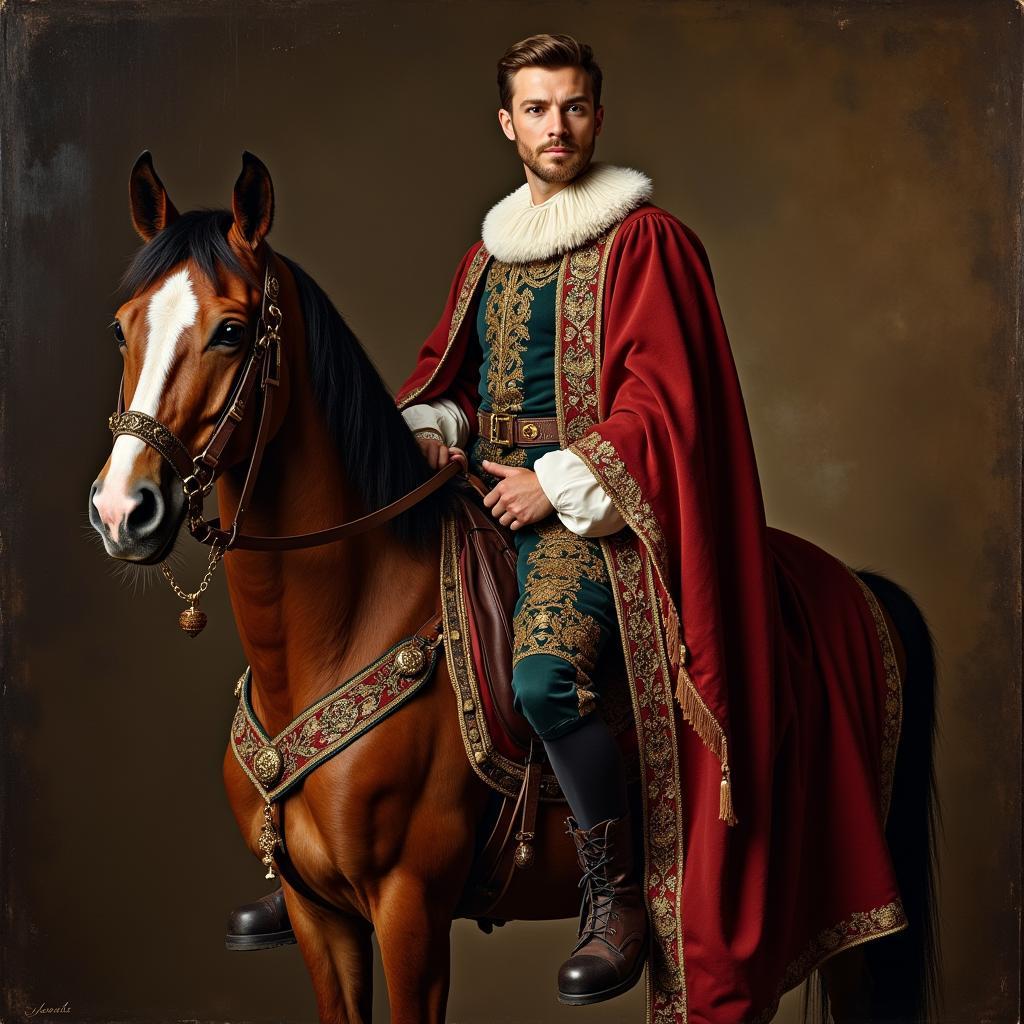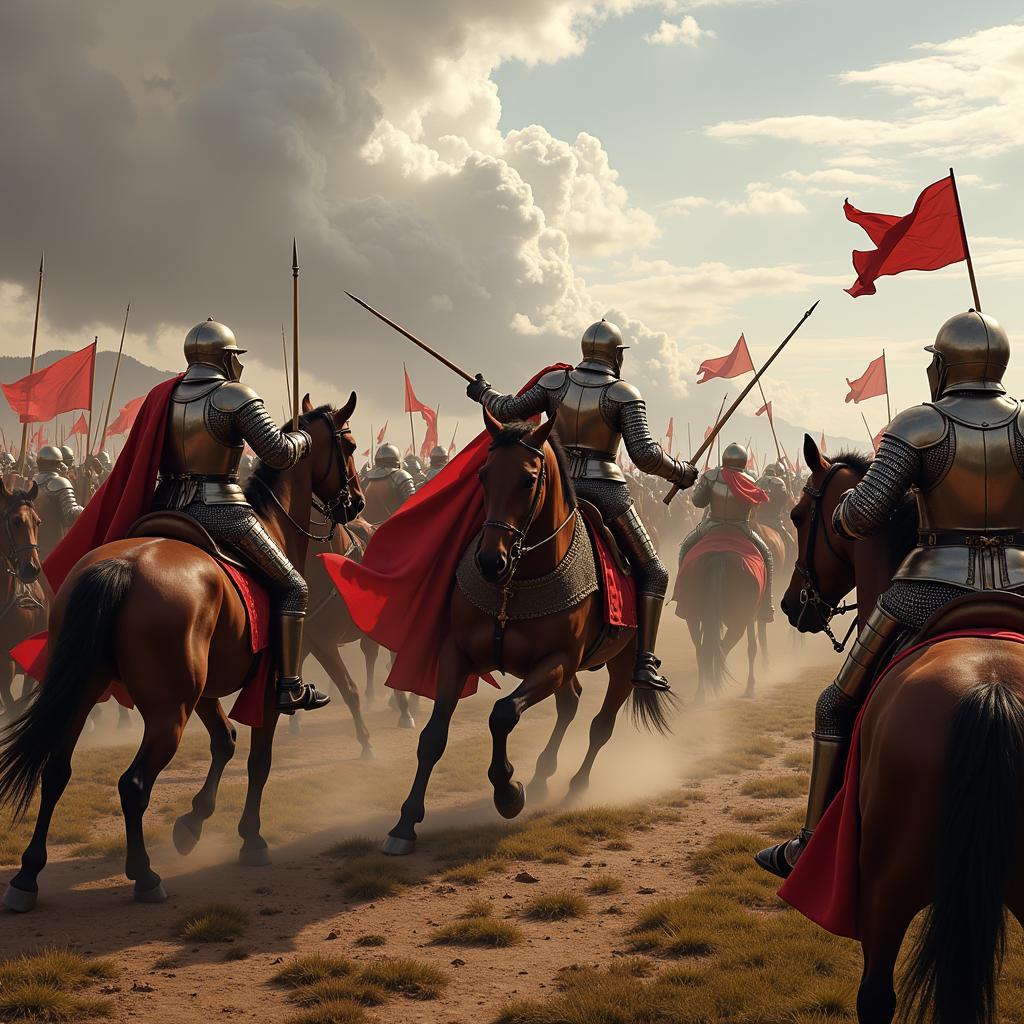The Renaissance, a period of great cultural and artistic transformation in Europe, witnessed a renewed appreciation for horses. More than just beasts of burden, Horses In The Renaissance became symbols of power, wealth, and social standing. They were integral to warfare, transportation, agriculture, and even art, leaving an undeniable mark on this fascinating era.
 Portrait of a Renaissance Nobleman on Horseback
Portrait of a Renaissance Nobleman on Horseback
The Horse’s Role in Renaissance Society
Horses played a pivotal role in the social fabric of the Renaissance. Owning a well-bred horse, especially those of noble lineage like the Neapolitan or Andalusian breeds, spoke volumes about one’s social standing. These animals were status symbols, much like luxury carriages or opulent homes are today.
Beyond personal prestige, horses were essential for:
- Warfare: The battlefield was where noble steeds truly shone. Knights relied on powerful warhorses, often clad in medieval horse armor for sale, to charge into battle, showcasing both their own bravery and the might of their house.
- Transportation: In an era before automobiles, horses were the primary mode of transportation for long distances. They facilitated trade, communication, and travel, connecting the various city-states and kingdoms that defined the Renaissance world.
- Agriculture: While oxen remained common for heavy plowing, horses were increasingly employed for lighter tasks like harrowing and transporting crops, boosting agricultural productivity.
 Horses in Renaissance Warfare
Horses in Renaissance Warfare
The Art of Equine Depiction
The Renaissance marked a turning point in how horses were portrayed in art. No longer relegated to stiff, symbolic representations, horses in Renaissance paintings and sculptures took on a new realism and dynamism. Artists like Leonardo da Vinci and Raphael meticulously studied equine anatomy, capturing their musculature, movement, and even their temperament with unprecedented accuracy.
- Leonardo’s Horse: Da Vinci’s unfinished equestrian statue of Francesco Sforza, though never completed, stands as a testament to his dedication to anatomical precision and his desire to capture the power and grace of these animals.
- Horses in Battle Scenes: Battle scenes, a popular subject in Renaissance art, frequently featured charging horses, their manes flowing, their nostrils flared, adding a sense of drama and movement to these works.
 Renaissance Horse Sculpture Detail
Renaissance Horse Sculpture Detail
The Legacy of Horses in the Renaissance
The bond between humans and horses deepened during the Renaissance. This era established a legacy that extended beyond practical uses, influencing the development of horsemanship, breeding, and our enduring fascination with these magnificent creatures. Whether depicted in art, celebrated for their role in shaping societies, or admired for their sheer beauty, horses in the Renaissance remain a captivating subject, offering a glimpse into a world where humans and animals were inextricably linked.
FAQs about Horses in the Renaissance
1. What breeds of horses were popular during the Renaissance?
The most sought-after breeds included the Neapolitan, Andalusian, Barb, and Friesian, prized for their elegance, strength, and suitability for war and courtly life.
2. How did the Renaissance change the way horses were trained?
The Renaissance saw a shift from harsh methods to more refined approaches influenced by classical horsemanship traditions. Writings on horsemanship emphasized understanding equine psychology and using gentle techniques to train horses for both war and leisure.
3. Did women ride horses during the Renaissance?
While women’s roles were often restricted, riding was considered an acceptable activity for noblewomen. They rode sidesaddle, a style developed for practicality and modesty, and their horses were often as richly adorned as their male counterparts.
4. Where can I find more information about historical horse breeds?
You can explore websites dedicated to horse breeds, such as Justus Horses USA, which offers insights into the history and characteristics of various breeds, including those popular during the Renaissance. For a touch of whimsy, you might even discover a jadeite horse among their offerings.
5. Are there any modern events that celebrate Renaissance horsemanship?
Yes, Renaissance fairs and historical reenactments often feature equestrian displays and competitions, allowing modern audiences to experience the thrill and skill of Renaissance horsemanship firsthand. You might even find inspiration for a costume for a horse to wear or even a dragon costume for a horse to add a touch of fantasy to these events.
We’d love to hear your thoughts! Share your questions about horses in the Renaissance or tell us what intrigues you most about this fascinating period in the comments below. And if you’re looking for a unique piece of equine art, be sure to check out the exquisite ceramic horse statue available on our website.
Need help finding the perfect equestrian companion or resources? Contact us at Phone Number: 0772127271, Email: [email protected] or visit us at QGM2+WX2, Vị Trung, Vị Thuỷ, Hậu Giang, Việt Nam. Our dedicated team is available 24/7 to assist you.